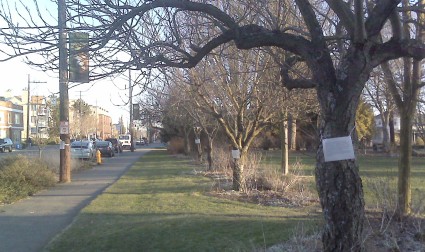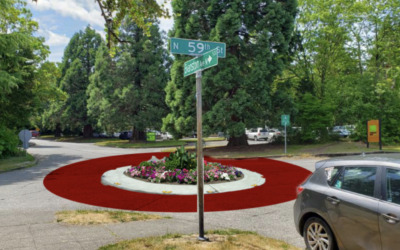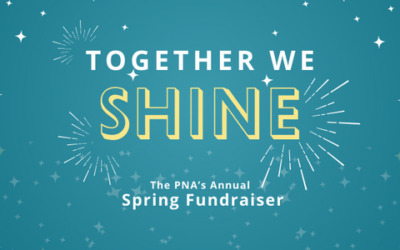
Due to the volume of feedback about plans to cut down four cherry trees along Phinney Avenue just south of 59th Street, Woodland Park Zoo Horticulturist David Selk asked for the opportunity to better describe why they need to go – and to say they’re postponing cutting the trees until after they bloom one more time.
A couple weeks ago Woodland Park Zoo attached a sign to each of four cherry trees along the east side of Phinney Avenue just south of 59th Street (West Woodland Playfield). The signs briefly explained the decision to remove these four trees due to declining health. Here is a bit more detail on the tree problems, the decision- making process, and the result of a number of phone calls received from our neighbors.
Cherry trees are susceptible to a number of fungal and insect problems. This has as much to do with our Western Washington climate (cool, wet winters and springs) as anything. By August the trees can be seen dropping their leaves, which have been infected by a fungus. Another issue is an insect called cherry bark tortrix. This is a moth that lays its eggs in natural openings in the tree and, when the eggs hatch, the larvae attack the vascular system. The adults start flying and laying in April, which is why we planned to remove the trees in March.
By removing these four particularly infected trees we hope to give the remaining five trees a better chance. A number of years ago we worked with WSU on an experimental parasite to the tortrix that gave us good results on some of our other cherries but these trees didn’t respond as well. We assume too much damage has been done to the trees and they have been weakened to a point that they are now susceptible to a wide range of pests and diseases.
We forecasted this problem and in anticipation of having to remove the trees we planted red maples right behind the cherry trees. The maples are now large enough and the cherries health compromised enough that it is time. We contacted Seattle Parks and Recreation Department arborist who concurred that their removal was warranted.
After posting the trees I received a number of phone calls. If there was one overriding message it was that people generally understood the need to remove the trees but requested we wait until they bloom one last time. As stated above there is a good reason for removing them now. However, the remaining five trees have lived with this problem these past years and one more season of bloom will probably not have a major impact on them.
So, fellow Phinney Ridgers, we have heard your request and have decided to postpone the tree removal until the bloom has finished. Tree removal is an emotional issue for all of us. The zoo has dedicated horticulture staff who nurtures our landscape as our life’s work. Believe me that we do not take tree removal lightly and do so only after completely exploring the alternatives. These trees really do need to come out for the betterment of the entire landscape. Thanks to all who have commented on this issue.
David Selk
Zoo Horticulturist




